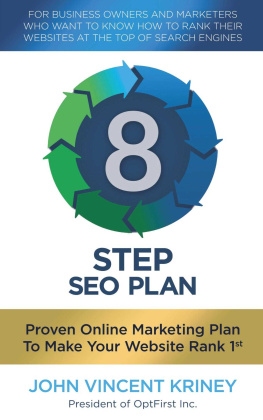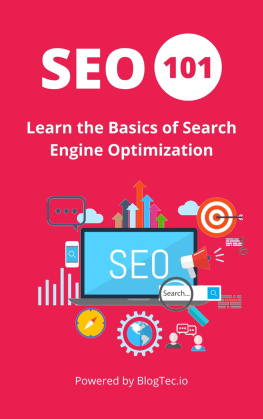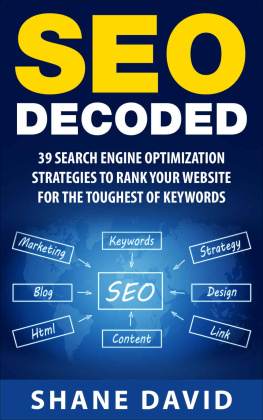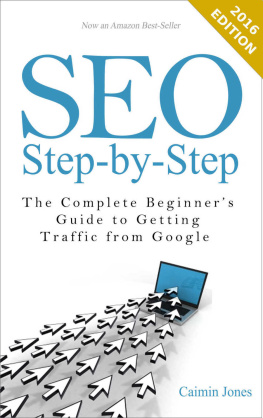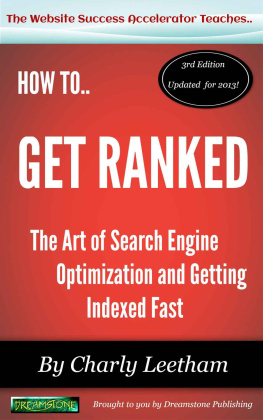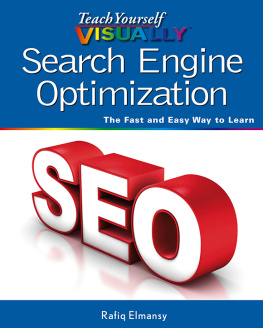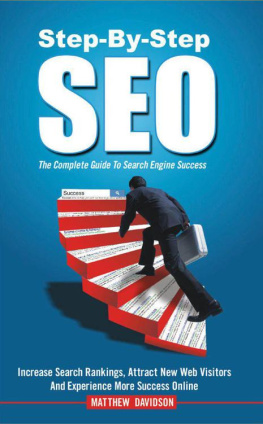The plan that changes an esoteric process into a tangible product.
All rights reserved. John Vincent Kriney grants no assignable permission to reproduce for resale or redistribution. This license is limited to the individual purchaser and does not extend to others. Except for the use of brief quotations within book chapters, permission to reproduce these materials for any purpose must be obtained in writing from the publisher.
Preface
2014 marked my 12th year of running my own marketing company. I had just finished answering one of my top-billing client s e-mails at 11:30 pm, marked URGENT! Most of the e-mails he sent me had some sort of end of days in the subject line. All of his subjects were in all capital letters. The fate of the world of course depended upon my immediate response. Only the day before, I had a meeting with an uptight, clueless, overly-confident client who thought that she knew just what it took to make her online website the next tutor.com. I was building a website for this client but the end of the project would not come soon enough for either of us, it seemed. I had created websites for billion dollar companies, but in her mind we were just not moving fast enough, well enough, or professionally enough.
Well, enough was enough. I had just wrapped up my numbers for the year, which was another year of 50% growth, but I was so frustrated that I was ready to close the doors. I told my wife that I was firing all my clients and focusing all my energy on my own websites. I have read every business management book out there, and all their tips seemed to ignore the fact that some clients are just a pain in the ass. Right as I was about to jump off my roof, (don t worry I live in a one-story house) my wife talked me off the ledge.
She asked me:
How many of your current clients are happy?
How many of your clients have achieved their target results?
How many clients have been making good money with your help using OptFirst?
How many clients are currently ranked 1st for their key phrases on search engines?
She and I both knew the answers. I had taken hundreds of companies from online zeroes to rock star heroes. These successful brick and mortar businesses, most of which would have been eaten up by online competitors, were turned into thriving enterprises, making good use of my balanced attack of real-world advertising and online positioning.
What my wife didntask me about was all the websites I had built over the past 12 years probably because she knew they were the most time consuming and least profitable part of my business. I figured since I was on the ledge, she was focusing on the things that she knew I was best at tackling. That s when I knew that Search Engine Optimization, SEO, needed to be OptFirst s specialty. We could build, alter, or focus on websites if and only if the work was needed for the purposes of SEO. The only problem was that my new primary target, the SEO industry, had the reputation as a field consisting of only charlatans and snake oil salesmen.
My largest early frustration with SEO was that I was being compared to other companies that claimed to offer the same product that I sell. These so-called competitors have given the industry a lousy reputation for a variety of reasons. I have discovered 3 types of SEO companies that have given my industry a bad name.
First come the large marketing agencies. These firms have high-spending clients, and they want to cater to the growing online market interests of these clients. In most cases, with no expertise or online marketing experience, these agencies offer Search Engine Optimization. These clients are used to spending $25,000 to $30,000 in just one month for a trial campaign. The client treats this SEO work as a test campaign and so does the marketing firm. The problematic issue here is that the campaign is overpriced and already doomed to fail due to the lack of expertise of the agency. The failure of these test campaigns leaves big companies with a poor opinion of SEO in general, and of the ROI it can provide.
The next problem that contributes to the bad reputation of the SEO industry is the myth of the brilliant SEO whiz kid that someone knows through a friend of a friend. We have all heard of this guy, the one who supposedly eats, sleeps, and thinks in search algorithms. This kid genius usually burns the website within 6 months. You may wonder how talented SEO kids can get a website in trouble with Google . The reason is surprisingly simple they are lazy. They frequently use automated processes to promote websites. They always opt into the latest link farm, link-building program, or any way to automatically get links pointing to their client s websites. The truth is that they prefer to spend less time doing real online PR and more time playing Xbox.
The third damaging type is the hardest to pick out of the lineup. This company uses safe link and citation-building practices, making them harder to detect, as they appear to be real SEO companies with real knowledge and techniques. Under further examination, however, they can be weeded out quite quickly. This type ignores all website performance data and visitor behavior data. They for some reason always have fixed prices

